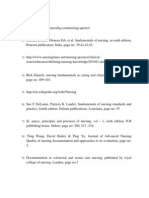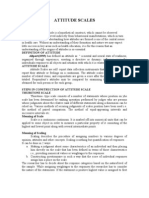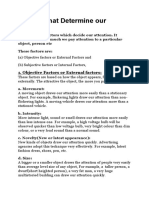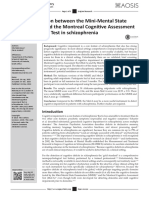DURATION and Degree of Attention
DURATION and Degree of Attention
Uploaded by
Florence School & College of NursingCopyright:
Available Formats
DURATION and Degree of Attention
DURATION and Degree of Attention
Uploaded by
Florence School & College of NursingOriginal Title
Copyright
Available Formats
Share this document
Did you find this document useful?
Is this content inappropriate?
Copyright:
Available Formats
DURATION and Degree of Attention
DURATION and Degree of Attention
Uploaded by
Florence School & College of NursingCopyright:
Available Formats
DURATION & DEGREE OF ATTENTION
There are Four major conditions of attention which are referred as
the duration and degree of attention. These are as follows:
1. Fluctuation of Attention
2. Distraction of Attention
3. Division of Attention
4. Span of Attention
1. Fluctuation of Attention:
It appears for us that our attention can be concentrated on a
particular thing or object or person for more time. But careful
observation clearly shows that we cannot concentrate on a single
thing or stimulus for more than few seconds.
When we are seeing an object or listening to a sound, after few
seconds, the attention will be shifted towards other stimulus or
other area of the stimulus for a few time and returns back to the
original or initial stimulus.
This process is called fluctuation.
(kisi chej pe focus karna, then kuch der baad attention koi aur chej
pe lagna, then kuch der baad wapas pehle wale chej pe
concentration wapas aajana)
2. Distraction of Attention:
When our attention is concentrated on a particular act or stimulus,
some other more powerful stimulus may draw our attention and
holds it to remain there for more time.
It mostly may not return to the earlier stimulus or sometimes
may return after much time.
For example, while reading a book, our concentration will be on the
book. Meanwhile if we listen to an attractive music sound, our
attention may be shifted towards that music and then we continue
to listen to that music for a longer time.
This is called Distraction of attention.
Students are much affected by distraction. Hence, they should learn
to have concentration of mind on studies.
3. Division of Attention:
Attending to more than one act at a time is known as division of
attention.
In such situations, we will divide our attention towards more than
one act. For example, a tailor will be stitching the cloths and also
speaking to his customers.
A nurse will be observing the pulse of a patient and also changes on
his face. We ride a scooter while speaking to our friends.
In such activities the attention is not divided, but it is possible to
perform more than one act because, either our attention is shifted
from one act to another rapidly, or our attention is concentrated on
only one act and the remaining activities are carried on
automatically.
4. Span of Attention
Span of attention is the amount of time that a person can
concentrate on a task without getting distracted.
An average adult human being has been found to have an attention
span of about 10 to 20 minutes. However, every person has different
level of capacity to focus on a particular thing or activity. Older
children and adults have better span of attention than young
children and old age people.
You might also like
- Physical Therapy Evaluation FormDocument4 pagesPhysical Therapy Evaluation FormBraga Dan100% (2)
- 2.4.2 Answer KeyDocument8 pages2.4.2 Answer KeyAndrew25% (4)
- Forensic NursingDocument50 pagesForensic NursingSurya Mohan Jha100% (1)
- NCP Acute Pain Related To EpisiotomyDocument1 pageNCP Acute Pain Related To EpisiotomySheryll Anne100% (2)
- Part-1+2-Care of The Patient With Body Elimination DeviationDocument44 pagesPart-1+2-Care of The Patient With Body Elimination DeviationSHREE SWAMINARAYAN NURSING COLLEGE CHIKHLINo ratings yet
- Growth and DevelopmentDocument64 pagesGrowth and DevelopmentRahul Dhaker100% (4)
- Health Illness ContinuumDocument11 pagesHealth Illness ContinuumSumit Yadav100% (8)
- Nurses Role in Providing Safe and Clean EnvironmentDocument19 pagesNurses Role in Providing Safe and Clean EnvironmentSharmila Hemalatha75% (4)
- Bio Physiological MethodsDocument4 pagesBio Physiological MethodsDelphy Varghese100% (2)
- Booster Class ABPSY HandoutsDocument16 pagesBooster Class ABPSY HandoutsEunice BasarioNo ratings yet
- Effectiveness of The Bobath Concept in The Treatment of Stroke: A Systematic ReviewDocument15 pagesEffectiveness of The Bobath Concept in The Treatment of Stroke: A Systematic ReviewAfrizal BintangNo ratings yet
- AttentionDocument34 pagesAttentionSTRANGE KHAN100% (2)
- Unit 6 Cognitive ProcessDocument29 pagesUnit 6 Cognitive ProcessHetal Pandya100% (2)
- Determinents or Factor of AttentionDocument2 pagesDeterminents or Factor of AttentionSuneel Kumar Prajapati100% (3)
- Mental Health & HygieneDocument6 pagesMental Health & HygieneArchakam Rakshitha100% (1)
- A Study to Assess the Knowledge of Primary School Teachers Regarding Behavioural Problems and their Prevention among School Going Children in Selected Government Primary Schools at Bagalkot with a View to Develop an Information BookletDocument25 pagesA Study to Assess the Knowledge of Primary School Teachers Regarding Behavioural Problems and their Prevention among School Going Children in Selected Government Primary Schools at Bagalkot with a View to Develop an Information BookletAnonymous izrFWiQ100% (3)
- (PART-C) Cet-Unit V Principles of Education &teaching and Learning ProcessDocument40 pages(PART-C) Cet-Unit V Principles of Education &teaching and Learning ProcessEllen AngelNo ratings yet
- Nursing Responsibilities For Oxygen AdministrationDocument3 pagesNursing Responsibilities For Oxygen AdministrationJahseh WolfeNo ratings yet
- Personality, Will and CharacterDocument18 pagesPersonality, Will and CharacterSteamNo ratings yet
- Audio AidsDocument18 pagesAudio AidsRavi Chaurasia100% (1)
- Unconsciousness DefinitionDocument5 pagesUnconsciousness DefinitionAbirajanNo ratings yet
- Causes and Risk Factors For Developing IllnessDocument19 pagesCauses and Risk Factors For Developing IllnessSumit Yadav100% (3)
- Personality Disorder PPT ROA FinalDocument51 pagesPersonality Disorder PPT ROA FinalDat boi40% (5)
- 1.3 Reactionof Ill Child To HospitalizationDocument21 pages1.3 Reactionof Ill Child To HospitalizationMUSLIHAH MD DESA100% (2)
- Mental Health Act PDFDocument40 pagesMental Health Act PDFAnilkumar JaraliNo ratings yet
- Psychotherapy 2Document28 pagesPsychotherapy 2lehsem20006985100% (2)
- Terminologies Used in Psy - NursingDocument56 pagesTerminologies Used in Psy - NursingTinju Joy100% (1)
- Patient EducationDocument18 pagesPatient Educationspalte48100% (1)
- Sponge Bath PDFDocument1 pageSponge Bath PDFa7wf100% (2)
- Terminologies Used in Nursing ResearchDocument6 pagesTerminologies Used in Nursing ResearchAmanda Scarlet100% (1)
- BibliographyDocument5 pagesBibliographyanurajoneNo ratings yet
- Lesson Plan On Vital SignsDocument20 pagesLesson Plan On Vital SignsJincy JohnyNo ratings yet
- Final Back CareDocument12 pagesFinal Back CareMonika Joseph50% (2)
- Barriers IN Interpersonal Relationship: By, Chakrapani ChaturvediDocument17 pagesBarriers IN Interpersonal Relationship: By, Chakrapani ChaturvediChakrapani ChaturvediNo ratings yet
- Personal Disorganization and Social GroupDocument33 pagesPersonal Disorganization and Social Groupkanchan kothariNo ratings yet
- Mobility and ImmobilityDocument4 pagesMobility and ImmobilityChin ChanNo ratings yet
- Hot Water BagDocument11 pagesHot Water BagangelNo ratings yet
- Demonstration of Comfort and Use of Comfort DevicesDocument9 pagesDemonstration of Comfort and Use of Comfort DevicesKrini Tandel100% (1)
- Balanced DietDocument40 pagesBalanced DietAkshatha ShivNo ratings yet
- Scope & Branches of PsychologyDocument6 pagesScope & Branches of PsychologyShwetaNo ratings yet
- Mental Orientation ReportDocument17 pagesMental Orientation ReportJitendra bhargav bhargavNo ratings yet
- Care of Unconscious PatientDocument5 pagesCare of Unconscious PatientRuchika Kaushal67% (3)
- Human Rights of Mentaly IllDocument13 pagesHuman Rights of Mentaly IllNikita Nelson100% (2)
- MT Vitals Signs - RespirationDocument11 pagesMT Vitals Signs - RespirationpriyankaNo ratings yet
- Comfort DevicesDocument55 pagesComfort Devicesmelby2604100% (1)
- Unit V Personality PDFDocument15 pagesUnit V Personality PDFOmprakash Swami100% (1)
- Mental Health LawsDocument30 pagesMental Health LawsJYOTI100% (2)
- MHN, I (U), 6Document51 pagesMHN, I (U), 6akila100% (1)
- Attitude ScalesDocument4 pagesAttitude ScalesMonika JosephNo ratings yet
- Mental Health TeamDocument3 pagesMental Health Teammanu sethiNo ratings yet
- Nursing Research VariablesDocument33 pagesNursing Research Variablesdr.anu RkNo ratings yet
- Clinical SociologyDocument8 pagesClinical SociologyHAFIZA MAIMOONA AMIN50% (2)
- Nursing Education Lesson Plan On Intradermal InjectionDocument12 pagesNursing Education Lesson Plan On Intradermal InjectionNisha Mwlz100% (1)
- Steam InhalationDocument17 pagesSteam InhalationRaju Teach Kaps100% (1)
- Subject: Mental Health Nursing - IDocument9 pagesSubject: Mental Health Nursing - Irupali kharabeNo ratings yet
- Aquathermia Pads:: A Device With A Small, ElectricallyDocument6 pagesAquathermia Pads:: A Device With A Small, ElectricallyLatisha VargaonkarNo ratings yet
- MSC (N) SyllabusDocument246 pagesMSC (N) SyllabussabeethuNo ratings yet
- Back CareDocument17 pagesBack CareHimani Patel100% (1)
- Unit 8 BSC 3rd YearDocument20 pagesUnit 8 BSC 3rd Yearsimonjosan100% (2)
- Qualities of A NurseDocument17 pagesQualities of A NurseSumit YadavNo ratings yet
- Sensory DeprivationDocument10 pagesSensory DeprivationAnusha VergheseNo ratings yet
- On Child Guidence ClinicDocument15 pagesOn Child Guidence ClinicSanjna Kumari (SNSR Senior Tutor/Lecturer)No ratings yet
- Attention in PsychologyDocument10 pagesAttention in PsychologyJohn henryNo ratings yet
- SEM 1 UNIT 3 - MGU Attention-Notes PDFDocument9 pagesSEM 1 UNIT 3 - MGU Attention-Notes PDFBhoomika VijayakumarNo ratings yet
- Unit 3: AttentionDocument18 pagesUnit 3: AttentionlNo ratings yet
- Growth and Development of AdolescntsDocument2 pagesGrowth and Development of AdolescntsFlorence School & College of NursingNo ratings yet
- Factors That Determine Our AttentionDocument3 pagesFactors That Determine Our AttentionFlorence School & College of NursingNo ratings yet
- Memory: Memory Is The Ability To Take in Information, Store It, and Recall It at A Later TimeDocument2 pagesMemory: Memory Is The Ability To Take in Information, Store It, and Recall It at A Later TimeFlorence School & College of NursingNo ratings yet
- Factors Influencing Our PerceptionDocument2 pagesFactors Influencing Our PerceptionFlorence School & College of Nursing100% (1)
- Errors in PerceptionDocument1 pageErrors in PerceptionFlorence School & College of NursingNo ratings yet
- Central Nervous System Disease PDFDocument4 pagesCentral Nervous System Disease PDFAnoop B Kodavoor100% (1)
- Sleep in Patients With Neurologic DiseaseDocument18 pagesSleep in Patients With Neurologic Diseasedr.cidgutNo ratings yet
- Galperin - Stage-by-Stage Formation As A Method of Psychological InvestigationDocument21 pagesGalperin - Stage-by-Stage Formation As A Method of Psychological InvestigationPamela CNo ratings yet
- Neurological Physical ExamDocument3 pagesNeurological Physical Examjyhn24No ratings yet
- CH 13 1 Reflex Arcs LabDocument21 pagesCH 13 1 Reflex Arcs Labapi-252045591No ratings yet
- Christina Chouman PPDocument10 pagesChristina Chouman PPapi-461338935No ratings yet
- Trends Q2Document4 pagesTrends Q2Sheldon Glenn Bacus SesbreñoNo ratings yet
- Somatic Symptom DisorderDocument26 pagesSomatic Symptom DisorderGAYATHRI NARAYANAN100% (1)
- Research Paper On Basic of Artificial Neural NetworkDocument5 pagesResearch Paper On Basic of Artificial Neural NetworkEditor IJRITCCNo ratings yet
- ATLS - Head Trauma ImodifiedDocument39 pagesATLS - Head Trauma ImodifiedSammon TareenNo ratings yet
- Evans Sea Remedies Contents Reading Excerpt 1Document12 pagesEvans Sea Remedies Contents Reading Excerpt 1isaiahNo ratings yet
- A Comparison Between The Mini Mental State Examination and The MoCA Test in SchizophreniaDocument6 pagesA Comparison Between The Mini Mental State Examination and The MoCA Test in SchizophreniaGuille NajarroNo ratings yet
- Cot 1 Nervous SystemDocument3 pagesCot 1 Nervous SystemHieronymus AlpantaNo ratings yet
- Approach To Stroke PatientDocument16 pagesApproach To Stroke PatientNEuRoLoGisT CoFFeeCuP100% (2)
- Lect 2 Descending Motor IMPROVED PathwaysDocument24 pagesLect 2 Descending Motor IMPROVED PathwaysMudassar Roomi100% (1)
- A Pattern Recognition Approach To MyopathyDocument49 pagesA Pattern Recognition Approach To MyopathyginadaisluNo ratings yet
- Multi-Sensory ArchitectureDocument34 pagesMulti-Sensory ArchitectureFiza Amim Khan100% (3)
- Asperger's Symptoms in Adults - Diagnosis, Treatment, and More - HOLLANDDocument11 pagesAsperger's Symptoms in Adults - Diagnosis, Treatment, and More - HOLLANDRoxan PacsayNo ratings yet
- NCP Head InjuryDocument3 pagesNCP Head InjuryAngel Mae Alsua100% (2)
- A New Scale For Measuring Insomnia-The Bergen Insomnia Scale PDFDocument16 pagesA New Scale For Measuring Insomnia-The Bergen Insomnia Scale PDFZubairNo ratings yet
- Sex Can Make You Smarter But Porn Can Make You DumberDocument6 pagesSex Can Make You Smarter But Porn Can Make You Dumberha_sunflowerNo ratings yet
- Spatial DisorientationDocument30 pagesSpatial Disorientationyan2901No ratings yet
- NIH Stroke Scale-1Document3 pagesNIH Stroke Scale-1Cecil MonteroNo ratings yet
- Neuro AssDocument33 pagesNeuro AssImee Balbido MallariNo ratings yet
- Q2 Week 4 Day 2Document4 pagesQ2 Week 4 Day 2chona redillasNo ratings yet






























































































